
BEST of Rig Rundown: Psych-Rock Pedalboards
Experience a sprawling collection of fuzz, delay, and modulation pedals that fuel massive walls of Pscyh-Rock sound. From vintage fuzz faces to boutique builds and custom creations, look back at classic Rig Rundowns from The Flaming Lips, All Them Witches, Elder, King Gizzard & The Lizard Wizard, and more.
Read more »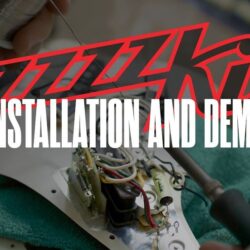
New BzzzzKill Device Solves Stratocaster 60Hz Hum Problem
The newly launched company BzzzzKill has introduced its debut product: a specially designed coil that drastically reduces hum in Stratocaster-style guitars.BzzzzKill solves a problem that has plagued Strat players for more than 70 years: single-coil pickup noise. The new BzzzzKill hum reduction device virtually eliminates Stratocaster 60 cycle hum without noticeable tone loss or permanent modifications to your guitar and its pickups.Unlike other solutions that require pickup replacements, permanent alterations, or external power sources, BzzzzKill employs a meticulously engineered passive dummy coil that installs inside your guitar’s control cavity without drilling.
On most Strat-style guitars, the installation process is straightforward and easily reversible, with no need for batteries, routing, or new pickups. Simply remove your pickguard, place the BzzzzKill coil next to the pickup selector switch, solder its wires to a few existing solder connections, and you’ll immediately hear a dramatic Improvement. Single-coil 60 Hz hum is virtually gone and your tone is retained.
BzzzzKill’s design finds the optimum balance between hum reduction and tone preservation. It’s currently available in two models. A Dual Layer model is specifically optimized for Stratocasters with reverse-wound/reverse-polarity (RWRP) middle coils. A Single Layer model is designed for vintage-style SSS (single-single-single) pickup configurations.
The innovative solution operates as a passive device requiring no batteries or maintenance, working in all pickup switch positions and remaining compatible with effects chains. The device maintains the guitar’s original dynamic range and low-end response while virtually eliminating hum at all gain levels except maximum gain settings, where only minimal hum remains.BzzzzKill is the culmination of decades of research and development by inventor Richard Moreton of RSM Custom Guitar Works. “I created over 200 prototypes in perfecting the BzzzzKill, mostly to solve my own quest for great tone and the ideal combination of hum reduction, and tone preservation,” says Moreton. “What started as a personal mission to get rid of the buzz in my own Strats became an obsession to create something that didn’t exist — one-and-done noise reduction without the compromises other solutions demand.”
Current BzzzzKill models sell for $199 USD for both the Single Layer and Dual Layer configurations. The company plans to expand to Telecaster and other single-coil models in the future. For more information visit www.bzzzzkill.com.
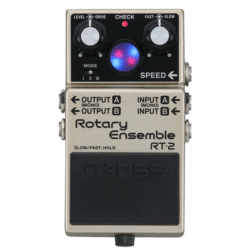
Boss RT-2 Rotary Ensemble Review
Ours is a frantically paced world. So, I quite like instruments and effects that slow my roll. Delays, reverb, and tremolo all do the trick nicely. But rotary-speaker-type effects can be every bit as good at slowing frantic, frenzied picking to a molasses pace.Whether a rotary-style pedal “spins” at a slow rate or a fast one … it’s all a lullaby to me. To truly distort time and have a decelerative influence, though, a rotary effect must create a real sense of depth. Boss’ RT-2 Rotary Ensemble possesses this kind of dimensionality in abundance. It’s syrupy and complex. And while it lacks some of the features that distinguish more embellished, contemporary rotary, vibrato, or Uni-Vibe-style pedals, the Boss’ smartly streamlined controls deliver subdued or in-your-face modulations in many shades, with functionality that doesn’t distract.Ode to RotationThough the RT-2 is, in many respects, a more compact riff on the Boss’ RT-20, which was discontinued in 2019, it isn’t as simple as it looks from five paces. The two knobs on the pedal’s face are actually four controls made up of two concentrically stacked dials. Two of the knobs set the speeds you move between when you press and hold the soft-latch pedal. The other two set the effect output level (which is handy for backgrounding or foregrounding the effect) and a drive circuit that approximates tube amp drive in a real rotary speaker. The drive control, though, can also be repurposed as a balance between virtual bass and treble “horns” when you slide a switch on the pedal’s crown. A second switch on the crown selects fast and slow ramp times between two rotary speeds.A third “mode” switch moves between three distinct effect voicings. The first, in Boss’s description, approximates the frequency response of a Leslie 122. To my ear it is the most open and neutral of the three. Mode II is described as having a wider tonal range more suited to drive and distortion. It’s much more focused in the midrange and slices like a machete when paired with a gain device or overdriven amp. Mode III is flat-out dirty, and while it sounds cool with distortion, it’s useful for achieving radical tone shifts in rigs with fewer effects. A lot of Hendrix and Gilmour fans will spend time here. The footswitch, in addition to functioning as the bypass, and the ramp switch can be reconfigured in different ways. Most notably, it can be used to activate the slowest rate of rotation first, or vice versa.Sundae SwirlThough some expensive, dedicated rotary speaker simulators may be better at achieving the mechanically derived, microtonal nuances of a real Leslie or Fender Vibratone, the RT-2 nails the mood and basic richness of the genuine article. The modulation pulses are distinctly hazy around the edges in a way a Uni-Vibe pedal or standard vibrato is not. At the slowest rates, these modulations can serve as a simple thickening agent in a fashion that almost mimics light boost or compression, particularly when the effect level is set to conservative zones. Faster modulations are more overtly rotary-like. Pitch shifts are less binary and bouncy and instead seem to melt into one another. And in a recorded mix with an appropriate sense of room ambience, you’d probably be hard-pressed to discern the RT-2 from a real Leslie.Though the drive control is effective for adding attitude and color to modulations, I derived a lot more utility and fun from using the control in its balance capacity. The ability to mix the virtual high and bass horns—effectively mimicking the microphone placement and mix emphasis when recording the treble and bass horns on a real Leslie—enables surgical placement of the effect in a mix. But it also helps summon the RT-2’s most natural and realistic rotary tones, and it’s the control I tinkered with most when exploring the pedal’s range.Accurately simulating a real rotary speaker remains one of the trickier feats in pedal design. Not coincidentally, the best simulators are pretty pricey. And while the RT-2’s $239 price tag can give pause, the pedal’s combination of no-fuss functionality, compact size, and often very delicious, convincing, and ecstatically elastic and animated approximations of a mechanical Leslie make crossing the $200 threshold a much more palatable proposition. And I’d venture that once you are fully immersed in the RT-2’s textures, and the surprisingly numerous, even unconventional, ways they can be applied, this well-executed pedal will pay back the investment many times over.
Read more »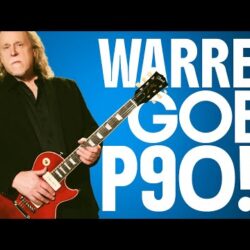
Why Warren Haynes chose P90s for his signature Les Paul — plus, a new finish for the Gibson Falcon?
Allman Brothers Band and Gov’t Mule man Warren Haynes visited Guitar World HQ in NYC to show us his new P90-sporting signature Gibson Les Paul — and to clue us…
Read more »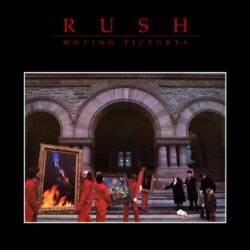
Alex Lifeson in the Limelight
Who could forget Alex Lifeson’s soul-stirring acceptance speech at the band’s 2013 induction to the Rock and Roll Hall of Fame: Yes, Rush are a “progressive rock band,” with all the weighty importance that it brings, but at their core is a sense of humor that allows them to not take themselves too seriously. The result is that, while their music may be complex at times, overall, it lacks the pretense and self-importance that can permeate bands of the genre.
Along with with late drummer Neil Peart’s masterful drumming and Geddy Lee’s vocals and powerfully melodic bass lines, it is Lifeson’s striking versatility that has made Rush one of rock’s most unique and compelling musical triangles for over 40 years:
Combining vast arrays of chiming chords …earworm-y riffs …thrilling solo flights …technical brilliance …and more, Lifeson’s inspiring creativity and musical savvy quickly become apparent to listeners. Let’s journey through some of the Canadian trio’s most classic songs to see if we can figure out just what makes him tick.Open Strings Are Our FriendsIn the debut episode of Premier Guitar’s Shred With Shifty, affable host and Foo Fighters guitarist Chris Shiflett, together with Lifeson himself, break down the latter’s solo from “Limelight,” off of 1981’s Moving Pictures. It kicks off with a clever use of a simple open B string, as shown in Ex. 1.Ex. 1As Lifeson explains, he doesn’t pick the harmonic. Instead, he lightly taps the ringing open string with a fret-hand finger at the indicated fret. (Lifeson uses his index; Shiflett, his middle.) Interestingly, the open B string wends its way through much of the song, including its trance-inducing chorus. Ex. 2 is inspired by this stirring section; note how the open B string acts as a hypnotic drone through all of the chords, a signature Lifeson move.Ex. 2You can take many open-position chord forms and experiment with moving them up the neck, while letting any open strings ring. Sure, you’ll inevitably hit some clunkers, but a good rule of thumb is, if the open string is in the key, you’ve got a good chance of finding some magic. Lifeson does just that in the intro to “La Villa Strangiato” from 1978’s epic, Hemispheres, as he positions a standard open G chord up at the 8th fret, creating a unique Cadd2 voicing.Ex. 3 is along the same lines; note how there are two open strings, D and G, that, when added to this very basic chord form, revitalize it to swirling effect.Ex. 3As in the “Limelight” solo, Lifeson cleverly weaves the open B string into his “YYZ” solo, Moving Pictures’ bombastic instrumental. Here, though, he employs it as a pedal point, a re-articulated or sustained note generally played below (or sometimes above) an accompanying melodic figure. Ex. 4 closes out his sinewy solo in grand fashion.Ex. 4Only the very first note is picked; the rest are sounded by a series of hammer-ons and pull-offs, which require some fret-hand strength to execute. A great exercise is to take the same figure and move it to other open strings, which is also a fun way to learn your scales horizontally across the neck. Throughout his solo, Lifeson employs B Phrygian dominant mode (B–C–D#–E–F#–G–A), which is simply the 5th mode of E harmonic minor (E–F#–G–A–B–C–D#). Fear not, all this means is that it’s the very same E harmonic minor scale, but here, B acts as the root or tonal center instead of E. Examples 5 and 6 apply this scale to the 1st and 3rd strings, respectively.Ex. 5Ex. 6Familiar Chords in Unfamiliar PlacesJust as how Lifeson uses open-position chord shapes up the neck with open strings, he also is adept at taking closed triad shapes (no open strings) and cleverly moving them in similar fashion. His solo in “Subdivisions,” from 1982’s Signals, rises to a climactic end this way, as shown in Ex. 7.Ex. 7This familiar “D” shape is one of three triad shapes found on each of the guitar’s sets of three strings. In other words, the same three notes (we’re excluding the open 4th string from the previous example) can be rearranged to find two other inversions along the neck. Let’s use them to play the same “Subdivisions” chord progression, but in different registers of the neck, as in Examples 8 and 9. Note in bar 2 of each how the new shapes lend themselves to different melodic choices and thus, new chord colors. Ex. 8Ex. 9Navigating Odd SpacesThe previous examples contain some interesting rhythms, something for which Rush is well-known, which includes the use of odd time signatures. Ex. 10 is reminiscent of a chordal interlude in “Jacob’s Ladder” from 1980’s Permanent Waves. Rush is a band that is exceptional at using odd time signatures in a most musical way, and here, they shrewdly shift from 5/4 to 6/4.Ex. 10To become more comfortable navigating these tricky time signatures, count either out loud or in your head while listening to the section. Doing so familiarizes you with how these time signatures feel, which eliminates the need for counting.Lifeson always sounds effortless when soloing in odd time signatures. A key way to accomplish this is to always be aware of where beat 1 is, so, for the moment, a bit more counting. But this time, do it while actually playing, as this will have you feeling at ease sooner than you might think. Lifeson’s solo in Moving Pictures’ “Red Barchetta” is in 7/4; note that an easy way to count your way through 7/4 is to break it down into 4/4 plus 3/4. Ex. 11 illustrates how he deftly negotiates one of the solo’s two-bar phrases in a memorably melodic way.Ex. 11The above is just a taste of the palette of colors from which Lifeson draws, as he weaves his guitars throughout Rush’s timeless catalog of songs. He, along with Lee and Peart, created unique and genuinely emotional music, none of which could ever be described as “blah.”
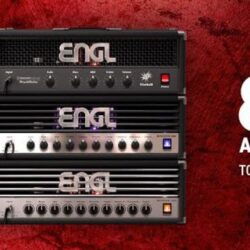
IK Multimedia Releases the ENGL Ampthology Volume 1Signature Collection for TONEX
IK Multimedia introduces ENGL Ampthology Vol 1, the first Signature Collection powered by the new TONEX Modeler. ENGL has earned a place among the most revered names in high-gain amplification, with a tone that has shaped the performance of metal, prog, and hard rock around the world.For the first time, that signature ENGL aggression and clarity have been captured directly from ENGL’s private vault of hand‑selected amps, meticulously curated for the official TONEX collection.”For decades, ENGL has defined the sound of high-gain excellence. With IK Multimedia’s TONEX technology, our iconic amps have been captured for you to unleash in the studio, on stage, or anywhere your music takes you.” – Edmund Engl, founder of ENGL AMPSENGL Collection Overview72 Tone Models based on six legendary amps from ENGL’s private collection, dialed in for this exclusive release.Created by ENGL tone masters using TONEX Modeler for enhanced high‑gain precision.Includes Amp, Amp + Cab, and Complex Rig Tone Models for ultimate flexibility in studio and live setups.Compatible across the entire TONEX ecosystem: Mac/PC, iOS, TONEX Pedal, and TONEX ONE.Compatible with all TONEX software versions, including the free TONEX CS.The Ultimate ENGL ExperienceENGL Ampthology Vol 1 offers instant access to six legendary ENGL amplifiers: the Fireball 60, Powerball MK1, Invader 100, Savage 120 MK1, Savage 60 MK1, and the pure tube tone of the ENGL Straight. Each amplifier offers a selection of exclusive Tone Models, including amp-only captures for maximum versatility.From crystal-clear cleans to crushing high-gain tones, with or without cab, these Tone Models capture authentic ENGL character in a mix-ready, studio-quality format that’s phase-perfect, ultra-responsive, and optimized for both studio and live use.Experience the full ENGL sound – without the volume, weight, or tube maintenance.Pricing and AvailabilityThe ENGL Ampthology Vol 1 is now available via ToneNET and within any version of TONEX for Mac/PC at a limited-time introductory price of $/€79.99* (reg. $/€99.99). *Pricing excluding taxes. For complete details and information about the ENGL Ampthology Vol 1 Signature Collection and to hear the tones, please visit: www.ikmultimedia.com/tonex-engl-vol1www.ikmultimedia.com/tonex-engl-vol1/video
Read more »Five For Friday: August 29, 2025
As we bid farewell to a pair of legends, let’s also celebrate the latest from Desaster, Sadistic Force and more!
The post Five For Friday: August 29, 2025 appeared first on Decibel Magazine.
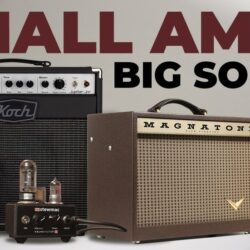
Small Amps, BIG Sound: Spark Mini, VF-1, Jupiter 45 & Starlite Reverb
From portable digital powerhouses to vintage-flavored tube tone machines, Premier Guitar contributor Tom Butwin puts four very different low-powered amps through their paces.If you’re a tinkerer searching for new tonal colors, a traveler who needs great sound in a compact package, or a tone chaser looking for the perfect studio companion, one of these amps has you covered. From quiet practice sessions to mic’d-up gigs, sometimes less really is more.
Read more »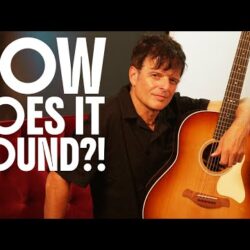
Taylor’s new Gold Label 717e SB acoustic guitar — walkthrough and demo
Acoustic guitar, anyone? Paul Riario checks out Taylor’s Gold Label 717e SB. Check out Paul’s pickin’ and tell us what you think in the comments! BTW, it’s got a sitka…
Read more »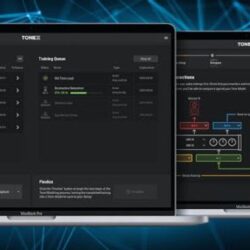
IK Multimedia Launches the New TONEX Modeler
FREE for all TONEX users, the standalone modeler adds batch processing, improves accuracy, increases reliability, and offers dramatically faster training times.IK Multimedia is proud to announce the launch of the new TONEX Modeler, a FREE update for all paid versions of TONEX, available today through the IK Product Manager as TONEX 1.10.0.Smarter. Faster. Perfect Tone.Developed by IK’s dedicated TONEX team, TONEX Modeler offers a variety of requested improvements and works seamlessly with TONEX software, ToneNET, and TONEX hardware, whether for capturing and creating Tone Models or performing live with more accurate and expressive Tone Models. TONEX Modeler OverviewFaster Training: Up to 87% quicker on modern GPUs and Apple Silicon Macs, with training times as short as 2 minutes.Extreme Tone Accuracy: Ultra-dynamic with harmonic clarity for high-gain amps.Batch Processing: Capture multiple rigs in a single session, then train later, even on another machine.Time-Saving Workflow: TONEX Modeler automatically stops training once the ideal results are achieved.Phase-Perfect Captures: Stereo rigs and DI blends remain perfectly aligned, essential for live performance.Ultra-Low Latency: Play with a natural, responsive feel both in the studio and on stage.Portable & Organized: Archive, export, and transfer captures easily across devices.Seamless TONEX Integration: Instantly load new models into TONEX and TONEX Editor.Professional, Unmatched ResultsEvery Tone Model produced by TONEX Modeler is phase-perfect and features ultra-low latency, ensuring that stereo rigs and bass DI blends sound flawless without requiring additional tweaks. The new capture engine also excels with high-gain tones, delivering tighter lows, richer harmonics, and crystal-clear definition-perfect for modern guitarists and producers who demand mix-ready sound straight from the capture.Batch Processing for Power UsersTONEX Modeler’s batch processing removes guesswork, saves time, and lets users capture once and process anytime, with the heavy lifting done automatically. Designed for today’s creators, it works smoothly with NVIDIA GPUs and Apple Silicon Macs, providing faster and more reliable performance. Its smart workflow even stops training early once peak quality is reached, so there’s less waiting and more creating.Tone Partners OnboardTONEX Tone Partners are experts whose feedback was crucial in developing the new TONEX Modeler. They received early access, and today IK is excited to share the results of this collaboration. Fifty-six new Tone Partner collections and bundles are now available on ToneNET for demo and purchase, showcasing the sonic enhancements of the new TONEX Modeler and providing over 1,140 new Premium Tone Models of sought-after rigs to explore. Pricing and AvailabilityThe TONEX Modeler is now available through the IK Product Manager as a FREE update for all paid versions of TONEX, including TONEX SE. TONEX Tone Partner Collections, created with the new TONEX Modeler, are now available for demo and purchase through ToneNET and in any version of TONEX for Mac/PC, starting at just $/€9.99* with Tone Partner bundles beginning at $/€39.99.
Read more »